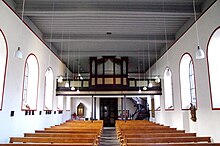St. Brigida (Untermaubach)
St. Brigida is the Roman Catholic parish church in the Kreuzau district of Untermaubach in the Düren district in North Rhine-Westphalia . The building is registered under number 57 in the list of architectural monuments in Kreuzau and is St. Consecrated to Brigida of Kildare .
history
A chapel existed in Untermaubach as early as 1350 . It was a half-timbered chapel . Since this, like today's church, is or was in the immediate vicinity of Untermaubach Castle , it can be assumed that it was a castle chapel.
Between 1619 and 1649 the old half-timbered chapel was replaced by a new chapel made of rubble stones. In 1804 Untermaubach, which was previously a branch of the parish of Kreuzau, was separated from the mother parish and raised to the status of an independent parish .
Today's church was built in 1816 and given a name in 1817. In 1834 the structure was expanded and rebuilt. It was a classical hall church made of rubble stones with a three-sided closed choir and a roof turret over the west gable.
During the Second World War , the parish church was badly damaged, with almost all of the interior furnishings being destroyed. Most of the damage had been repaired by 1949. In 1976, a comprehensive renovation followed according to plans by the Zülpich architect Karl-Josef Ernst . The re-inauguration took place on September 17, 1976.
Furnishing
There is modern equipment in the church. The stained glass windows are works by Paul Weigmann and depict geometries with leaf and fruit motifs.
organ
The oldest parts of the organ of St. Brigida date back to 1760. The organ builder is unknown. In 1885 the instrument was restored by the Gebrüder Müller organ builder from Reifferscheid . In 1985, the organ building workshop Heinz Wilbrand from Übach-Palenberg restored and expanded the organ again. Since 1985 the organ with mechanical slide chests has the following 18 registers :
|
|||||||||||||||||||||||||||||||||||||||||||||||||||||||||||||||||
Bells
There are two bells in the roof turret of St. Brigida . The larger bell was cast by Wilhelm Mabilon from Mabilon & Co. from Saarburg in 1927. He cast another, larger bell in 1927, which, however , had to be given up for war purposes in the course of the Second World War and was finally melted down. The smaller bell is a loan bell from Groß-Lessen in Lower Silesia , today Poland. It was created in 1464 by an unknown founder.
|
No. |
Surname |
Diameter (mm) |
Mass (kg, approx.) |
Percussive ( HT - 1 / 16 ) |
Caster |
Casting year |
| 1 | - | 837 | 344 | h ' −4 | Wilhelm Mabilon, Mabilon & Co., Saarburg | 1927 |
| 2 | Christ the King | 697 | 180 | d " −9 | Unknown | 1464 |
Web links
Individual evidence
- ^ Catholic parish church of St. Brigida in Kreuzau - Untermaubach. In: Homepage of Käthe and Bernd Limburg. Retrieved September 22, 2016 .
- ^ Churches in the region - St. Brigida in Untermaubach. In: Kirchenmusik-Dueren.de. Retrieved September 22, 2016 .
- ↑ Kreuzau-Untermaubach, Catholic Church of St. Brigida. In: Forschungsstelle Glasmalerei des 20. Jahrhundert e. V. Accessed September 22, 2016 .
- ^ Organs in the region - St. Brigida in Untermaubach. In: Kirchenmusik-Dueren.de. Retrieved September 22, 2016 .
- ^ Norbert Jachtmann: Bells in the Düren region, p. 198 f.
Coordinates: 50 ° 43 ′ 35.5 ″ N , 6 ° 27 ′ 19.9 ″ E



